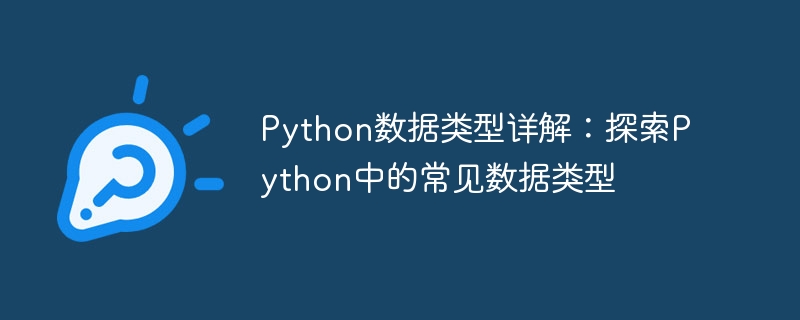深入了解Python中常见的数据类型
- 王林原创
- 2024-01-20 08:43:14980浏览

深入了解Python中常见的数据类型
引言:
在Python编程语言中,数据类型是非常重要的概念。了解数据类型的特性以及如何正确使用它们,可以在编写Python程序时提高效率,减少错误。本文将详细探索Python中常见的数据类型,并给出具体的代码示例。
- 数字类型
在Python中,最常见的数字类型是整数(int)和浮点数(float)。整数用于表示无小数部分的数字,而浮点数用于表示有小数部分的数字。
以下是使用整数和浮点数的示例代码:
# 整数 a = 10 b = -5 # 浮点数 c = 3.14 d = -2.5 # 运算 result1 = a + b result2 = c * d print(result1) # 输出: 5 print(result2) # 输出: -7.85
- 字符串类型
字符串是Python中用于表示文字序列的数据类型。在Python中,字符串需要用引号(单引号或双引号)括起来。
以下是使用字符串的示例代码:
# 字符串 name = "Alice" message = 'Hello, world!' # 字符串拼接 greeting = "Hi, " + name + "!" print(message) # 输出: Hello, world! print(greeting) # 输出: Hi, Alice!
- 列表类型
列表是Python中最常用的数据类型之一,它允许存储多个元素,并可以根据需要进行增删改查操作。
以下是使用列表的示例代码:
# 列表
fruits = ['apple', 'banana', 'orange']
# 添加元素
fruits.append('pear')
# 删除元素
fruits.remove('apple')
# 修改元素
fruits[1] = 'grape'
# 查找元素
index = fruits.index('orange')
print(fruits) # 输出: ['banana', 'grape', 'orange', 'pear']
print(index) # 输出: 2
- 元组类型
元组是与列表类似的数据类型,它也可以存储多个元素,但一旦创建后就不能修改。
以下是使用元组的示例代码:
# 元组
weekdays = ('Monday', 'Tuesday', 'Wednesday', 'Thursday', 'Friday')
# 元素访问
first_day = weekdays[0]
last_day = weekdays[-1]
print(first_day) # 输出: Monday
print(last_day) # 输出: Friday
- 字典类型
字典是一种以键值对形式存储数据的数据类型。每个键值对都由一个键和一个值组成,并且可以根据键来访问和修改对应的值。
以下是使用字典的示例代码:
# 字典
student = {
'name': 'Alice',
'age': 20,
'major': 'Computer Science'
}
# 添加键值对
student['gender'] = 'Female'
# 修改值
student['age'] = 21
# 访问值
name = student['name']
print(student) # 输出: {'name': 'Alice', 'age': 21, 'major': 'Computer Science', 'gender': 'Female'}
print(name) # 输出: Alice
- 集合类型
集合是一种用于存储不重复元素的数据类型。集合可以进行交集、并集、差集等常见的集合运算。
以下是使用集合的示例代码:
# 集合
fruits = {'apple', 'banana', 'orange'}
colors = {'red', 'green', 'orange'}
# 交集
intersection = fruits & colors
# 并集
union = fruits | colors
# 差集
difference = fruits - colors
print(intersection) # 输出: {'orange'}
print(union) # 输出: {'red', 'green', 'banana', 'orange', 'apple'}
print(difference) # 输出: {'apple', 'banana'}
结论:
本文详细介绍了Python中常见的数据类型,包括数字类型、字符串类型、列表类型、元组类型、字典类型和集合类型。每种类型都有其独特的特性和用途,掌握它们可以帮助我们更好地使用Python编程语言来处理各种数据。
无论您是初学者还是有经验的开发人员,对于数据类型的理解和运用是编程过程中至关重要的一部分。因此,希望本文对您的Python编程之旅有所帮助,并能在实际编码过程中给予一定的指导和灵感!
以上是深入了解Python中常见的数据类型的详细内容。更多信息请关注PHP中文网其他相关文章!
声明:
本文内容由网友自发贡献,版权归原作者所有,本站不承担相应法律责任。如您发现有涉嫌抄袭侵权的内容,请联系admin@php.cn

